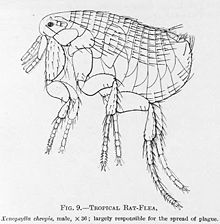- Oriental rat flea
-
Oriental rat flea 
Scientific classification Kingdom: Animalia Phylum: Arthropoda Class: Insecta Order: Siphonaptera Family: Pulicidae Genus: Xenopsylla Species: X. cheopis Binomial name Xenopsylla cheopis
(Rothschild, 1903)[1]The Oriental rat flea (Xenopsylla cheopis), also known as the tropical rat flea, is a parasite of rodents, primarily of the genus Rattus, and is a primary vector for bubonic plague and murine typhus. This occurs when the flea has fed on an infected rodent, and then bites a human. The oriental rat flea is most infamous for contributing to the Black Death.
Contents
Body structure
The Oriental rat flea has no genal or pronotal combs. This characteristic can be used to differentiate the oriental rat flea from the cat flea, dog flea, and other fleas.
The flea's body is only about one tenth of an inch long (about 2.5 mm). A flea's body is constructed to make it easier to jump long distances. The flea's body consists of three regions: head, thorax, and abdomen. The head and the thorax have rows of bristles (called combs) and the abdomen consists of eight visible segments.
A flea's mouth has two functions: one for squirting saliva or partly digested blood into the bite, and one for sucking up blood from the host. This process mechanically transmits pathogens that may cause diseases the flea might have. Fleas smell exhaled carbon dioxide from humans and animals and jump rapidly to the source to feed on the newly found host. A flea is wingless so it can not fly, but it can jump long distances with the help of small powerful legs. A flea's leg consists of four parts. The part that is closest to the body is the coxa. Next is the femur, tibia and tarsus. A flea can use its legs to jump up to 200 times its own body length (about 20 in/50 cm). It can also jump about 130 times its own height (about 13 in/33 cm).
Life cycle
There are four stages in a flea's life. The first stage is the egg stage. Microscopic white eggs fall easily from the female to the ground or from the animal she lays on. If they are laid on an animal, they soon fall off in the dust or in the animals bedding. If the eggs do fall immediately on the ground, then they fall into crevices on the floor where they will be safe until they hatch one to ten days later (depending on the environment that they live in, it may take longer to hatch). They hatch into a larva that looks very similar to a worm and is about two millimeters long. It only has a small body and a mouth part. At this stage, the flea does not drink blood; instead it eats dead skin cells, flea droppings, and other smaller parasites lying around them in the dust. When the larva is mature it makes a silken cocoon around itself and pupates. The flea remains a pupa from one week to six months changing in a process called metamorphosis. When the flea emerges, it begins the final cycle, called the adult stage. A flea can now suck blood from host and mate with other fleas. A single female flea can mate once and lay eggs every day with up to 50 eggs per day.
Experimentally, it has been shown that the fleas flourish in dry climatic conditions with temperatures of 20–25 °C (68–77 °F).[2] They can live up to a year and can stay in the cocoon stage for up to a year if the conditions are not favourable.
History
The rat flea was one of the major causes of the Black Death. It was collected in Egypt by N. C. Rothschild along with Karl Jordan and described in 1903.[3] He named it cheopis after the Cheops pyramids[citation needed].
Diseases transmission
This species can act as a vector for plague, Yersinia pestis, Rickettsia typhi and also act as a host for tapeworms Hymenolepis diminuta and Hymenolepis nana. Diseases can be transmitted from one generation of fleas to the next through the eggs.[4]
References
- ^ N. C. Rothschild (1903). "New species of Siphonaptera from Egypt and the Soudan". Entomologist's Monthly Magazine 39: 83–87.
- ^ J. F. D. Shrewsbury (2005). A History of Bubonic Plague in the British Isles. Cambridge University Press. pp. 3. ISBN 0521022479.
- ^ Manuscript, Drawing and Photograph Collection of Nathaniel Charles Rothschild (1877–1923)
- ^ A. Farhang-Azad, R. Traub & S. Baqar (1985). "Transovarial transmission of murine typhus rickettsiae in Xenopsylla cheopis fleas". Science 227 (4686): 543–545. doi:10.1126/science.3966162. PMID 3966162.
External links
- http://animaldiversity.ummz.umich.edu/site/accounts/information/Xenopsylla_cheopis.html
- http://parasitology.informatik.uni-wuerzburg.de/login/n/h/0525.html
- Natural Flea Control Remedies Authoritative book of many natural flea control methods
Categories:- Fleas
- Rodent-carried diseases
- Biting insects
- Insect vectors of animal pathogens
- Insect vectors of human pathogens
- Animals described in 1903
Wikimedia Foundation. 2010.

